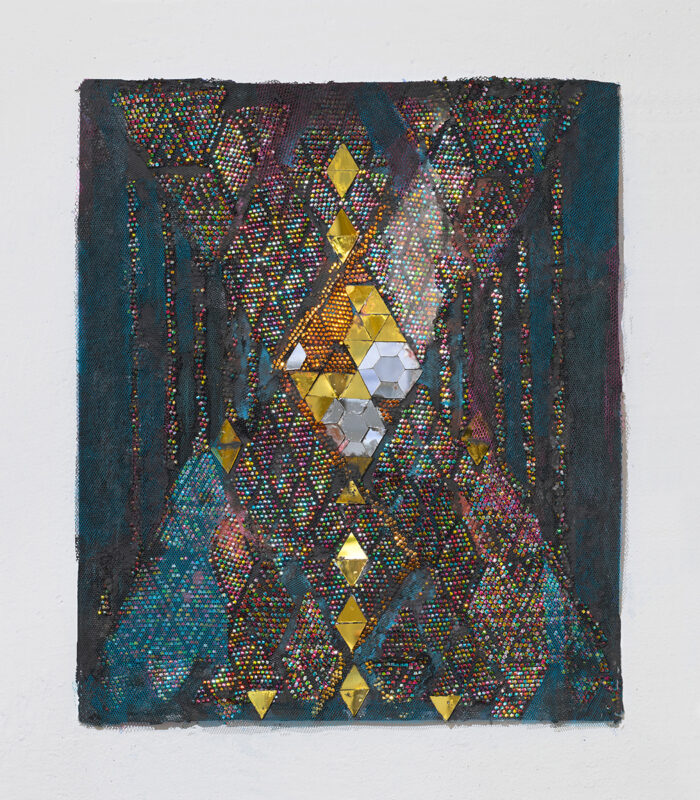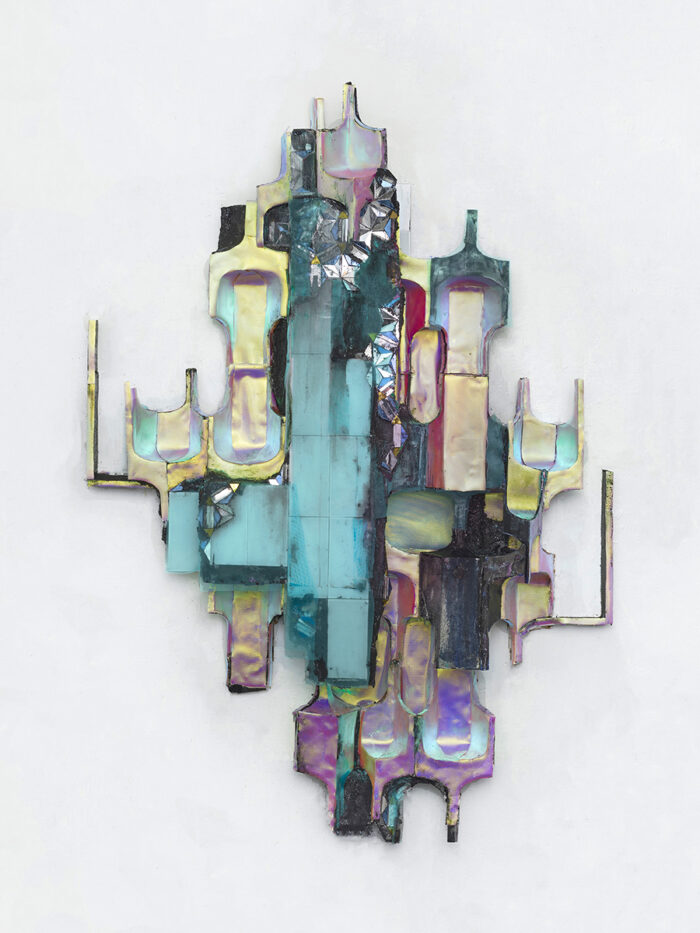Matter can neither be created nor destroyed. Only transformed. Armita Raafat’s artistic practice centers around transforming her materials from one form to another, along with their associated concepts, histories, and interpretations. Raafat’s exhibition at High Noon Gallery, Traces and Silences, displays this materially transformative artmaking process through wall-mounted sculptures and handmade paper works. Each work in the show contains materially and conceptually significant fragments: bits and pieces that coalesce into surprising new hybrid forms.

Most of the wall sculptures in the show are based on muqarnas, an ornamental vaulting element characteristic of classical Islamic architecture. Muqarnas often line the undersides of domes, forming intricate honeycomb or stalactite patterns when viewed from below. Raafat’s cast resin muqarnas are more accessible and intimate, mounted just sixty inches from the floor rather than a hundred feet in the air or more. When viewed in isolation from their larger architectural and historical contexts, these elements take on new meanings. While each muqarnas shape feels simple, like a minimalist sculpture, when aggregated and arranged, they become a complex maximalist work. And Raafat further augments them with a wide variety of materials: mirrors, glass, mesh, and more.

Each fragment Raafat uses in her work has a history. This history is straightforward for some, but others have more complex stories behind them. The untitled light blue sculpture hanging by the gallery entrance contains fragments of an antique reverse-painted mirror from Iran’s Qajar dynasty embedded in its surface. While not as widely recognized or iconic as muqarnas, these mirrors were also used as decorative elements in historical Iranian architecture. While shopping for tiles, Raafat found these mirrors at the Vakil Bazaar in Shiraz, Iran. An antique dealer gave her a broken reverse-painted mirror as a gift, and she later commissioned another dealer to track down more of them. The mirror shards retain their swirling botanical motif, a pattern echoed by ribbons of ruffled glass mounted around the largest mirror fragment protruding from the blue muqarnas. A harmonious whole was fractured, but Raafat has assembled a new, more compelling harmony from its fragments, a fusion of the historical and the contemporary.

Raafat embeds fragments directly in the sheets of her handmade paper works. The most noteworthy of these fragments are pieces of khoos doozi embroidery. Khoos doozi is a craft technique traditional to the southern Iranian province of Hormozgan, particularly the island of Qeshm, and artisans use this technique to embellish scarves, wedding dresses, and other garments. The technique is traditionally passed down in families, from grandmother to mother to daughter. Raafat worked with six women from the island, commissioning new works of embroidery specifically for inclusion in these handmade paper pieces. As with muqarnas, each khoos doozi piece consists of simple elements that gain complexity through conglomeration, like cells clumping together to form the tissues that form organs. Polygonal threads combine into diamond shapes, and the diamonds form another, larger pattern. The gleaming metallic threads of khoos doozi embroidery immediately stand out from the dark, highly pigmented paper pulp in which they are embedded. Raafat amplifies this contrast by adding pieces of mirrors. In the work pictured above, triangular mirrors interact with the diamond shapes of khoos doozi fragments, complementing and expanding upon the existing design. A hybrid of traditional craft and contemporary art, this piece pulls elements from each world and synthesizes them into something new and unique.

The merger of history with materiality is part of what makes Raafat’s work compelling. She breaks apart and reassembles historical motifs and traditional crafts, transposing their histories and stories to the context of the contemporary art world. Each artwork consists of many elements, a diverse arrangement of disparate fragments cohering together by the force of the artist’s vision and will. Nothing is untouched—everything has been broken, shattered, manipulated, and reassembled into something new. Not created or destroyed . . . . but transformed.
